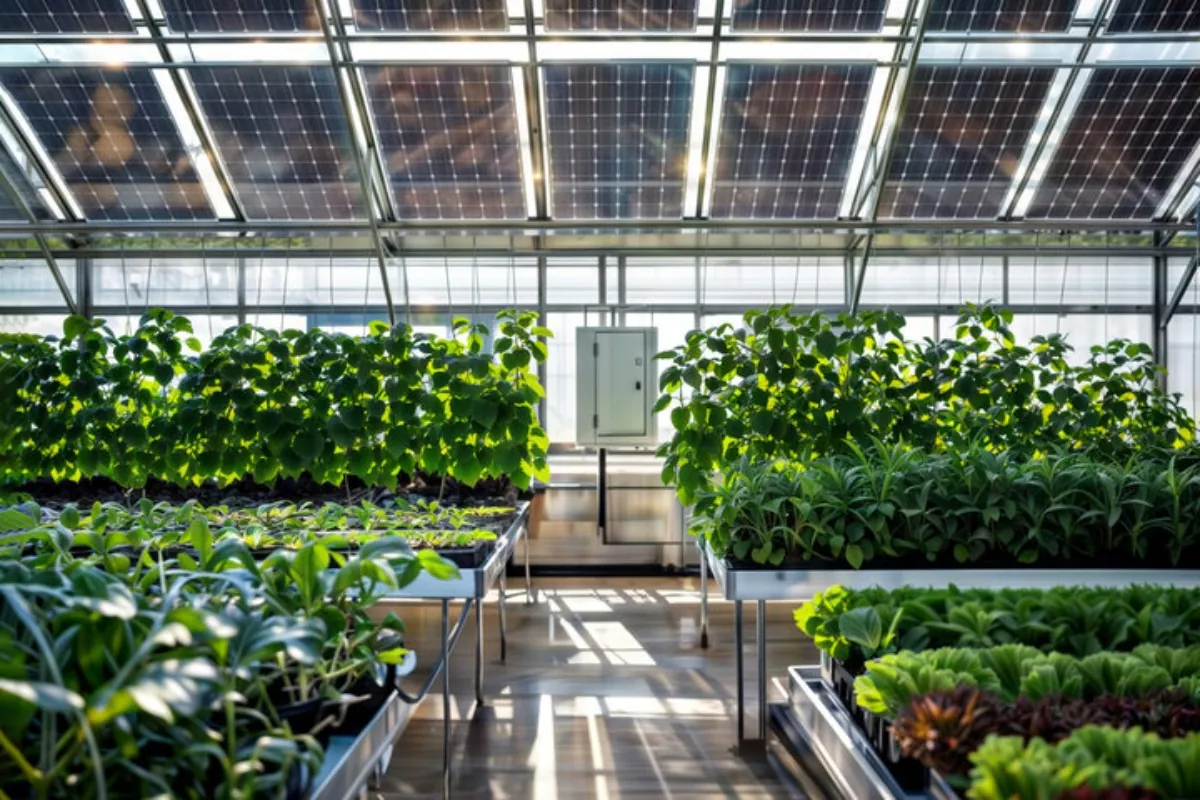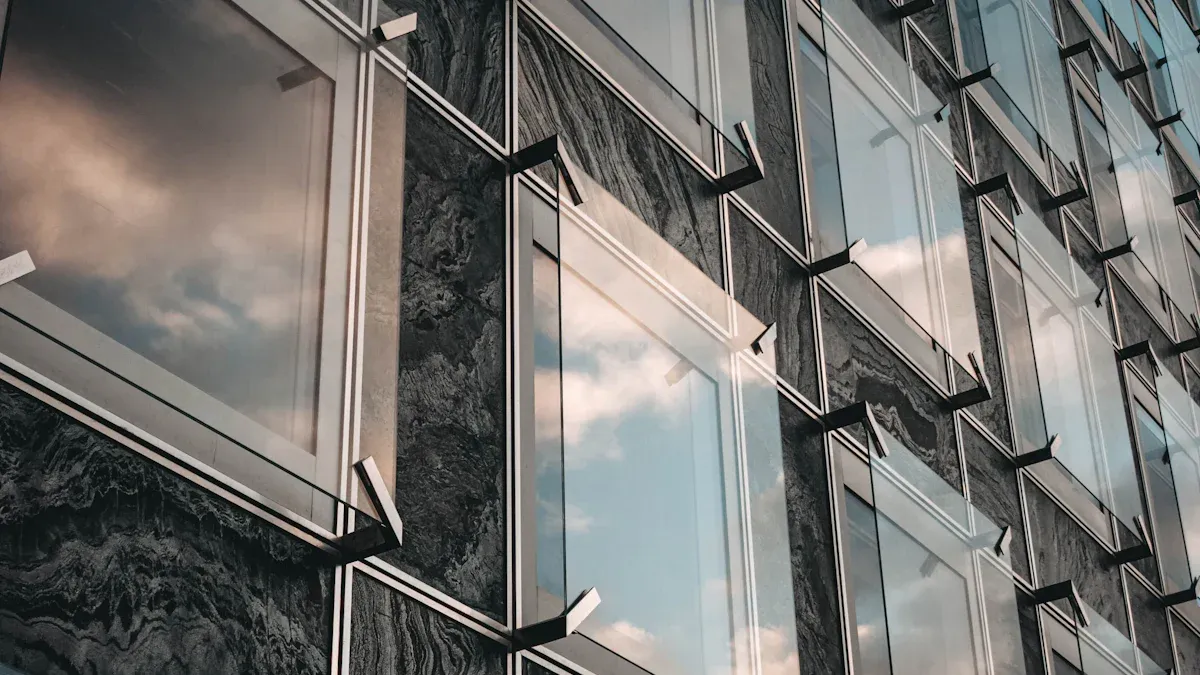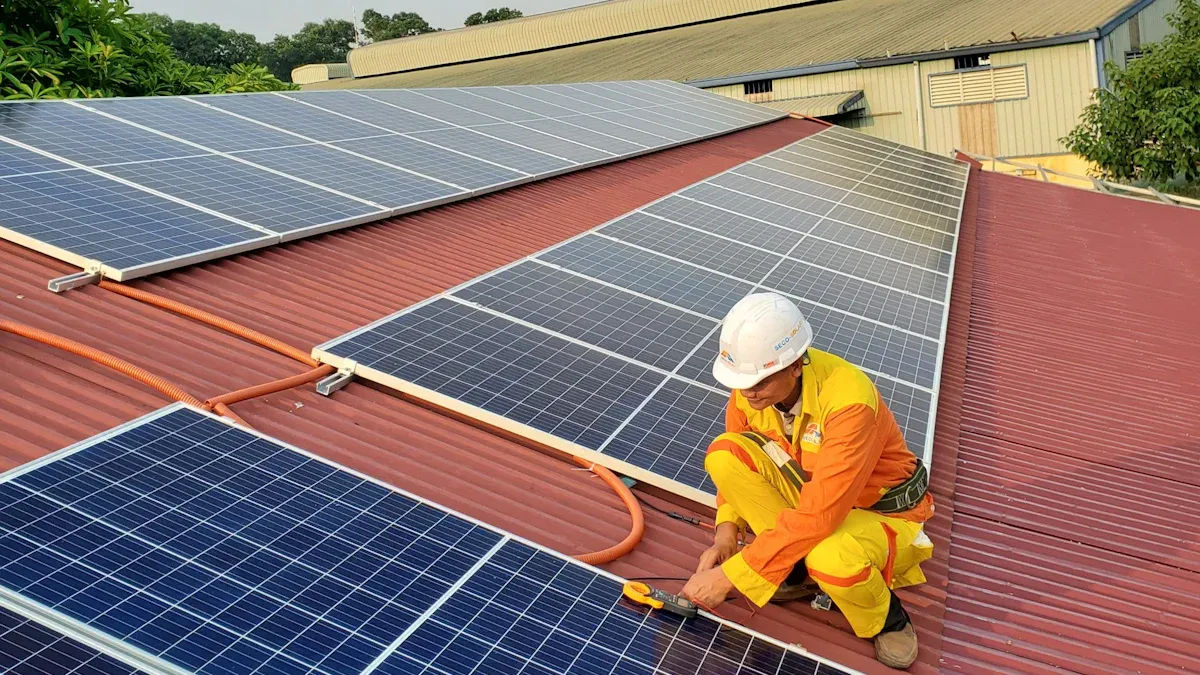+86 17727759177
inbox@terli.net
- All
- Product Name
- Product Keyword
- Product Model
- Product Summary
- Product Description
- Multi Field Search
Views: 0 Author: Site Editor Publish Time: 2025-10-23 Origin: Site
You can make buildings use less energy with semi-transparent pv panels. These panels help keep buildings comfortable. They work at efficiency rates from 1% to 10%. Traditional solar panels often work at 20% or more. New technology makes these panels stronger. It also makes them easier to put in windows and glass walls. They use organic photovoltaic cells and perovskite solar cells. You get two big benefits. These panels make electricity from ultraviolet and infrared light. They also let visible light into rooms to make them bright.
| Panel Type | Efficiency Rate | Transparency Level |
|---|---|---|
| Semi-transparent solar panels | 1% - 10% | ~60% |
| Traditional solar panels | 20% or more | N/A |
| Most efficient panels | 22-23% (up to 30% in labs) | N/A |
Things like transparency, window-to-wall ratio, and coverage affect how well these panels work in buildings.

Semi-transparent PV panels make electricity and let sunlight in. This helps buildings feel nicer and saves money on energy bills. These panels fit into windows, walls, and skylights. They work well for homes and businesses. You need to pick the right mix of see-through and power. More see-through means more light but less energy made. Clean the panels two times each year to keep them working well and lasting longer. Think about both the good and bad sides of semi-transparent PV panels. This helps you choose what is best for your building’s energy needs.
Transparent solar panels can make electricity and keep rooms bright. They have special coatings that take in UV and IR light. Visible light goes through, so you still get daylight. Some panels use Zn(OS) nanometric layers. These can be up to 75% see-through. Others use a-Si nanometric layers. These let in 35% to 60% of light and work at up to 2% efficiency. Some panels use organic polymers. These focus on IR light and can reach 5% efficiency. They stay between 41% and 59% see-through. Transparent solar panels let at least 45% of visible light pass. This helps save energy and lets plants grow inside.
Transparent solar panels take in UV and IR light to make power.
You get lots of daylight, so rooms are bright.
Some panels use new materials for better see-through and power.
These panels are good for windows, skylights, and building fronts.
Semi-transparent pv panels and traditional solar panels work differently. Transparent solar panels usually have less than 10% efficiency. Traditional opaque panels can reach about 25%. Most semi-transparent photovoltaic panels work between 7% and 12%. Newer ones can go up to 12.3%. The table below shows how they compare:
| Panel Type | Conversion Efficiency |
|---|---|
| Semi-transparent PV panels | Less than 10% |
| Traditional opaque panels | Around 25% |
Traditional solar panels can turn up to 22% of sunlight into power. Transparent solar panels often reach only 2% to 10%. You get less power but more daylight and nicer building looks. The see-through level changes how much power you get. More see-through means more light comes in, but less energy is made. This lowers how much power the panels can make.
You must balance see-through and power when picking transparent solar panels. More see-through means more light in your building. But this also means less energy is made. For example, panels with over 70% see-through reach about 4% efficiency. Panels with over 80% see-through drop to 2.38% efficiency.
| Transparency Ratio | Device Efficiency (%) |
|---|---|
| > 70% | 4.06 |
| > 80% | 2.38 |
Selective light absorption is important for how well panels work. Transparent solar panels block UV and near-infrared light. They let in lots of visible light, which helps with daylight and how the building looks. This balance lets you get power from UV and IR light. You can make electricity and still have nice windows or glass walls. Semi-transparent photovoltaic panels help buildings use less energy. They give power and help keep rooms comfy. You need less energy for heating and cooling. These panels cut down glare and make it easier to see. For example, CdTe BIPV windows let in only 20% solar heat. Single glazing lets in 72.8%. The U-value for CdTe BIPV is 2.7 W/m²K. Single glazing has a U-value of 5.7 W/m²K. You save energy and make your building nicer.
Tip: When picking transparent solar panels, try to find the best mix of see-through and power. This way, you get more daylight and solar energy.

You can put transparent solar panels in many places on a building. These panels fit into windows, facades, and skylights. You do not need extra frames to hold them. The panels have layers like strong glass, a clear coating, and a special solar layer. This setup gives you power, keeps heat in, and blocks UV rays. Using these panels helps your building look new and saves energy. You can even use them instead of normal glass windows. This makes your building use less energy and stay comfy inside.
Transparent solar panels work for homes and businesses. You can see them in schools, offices, stores, and houses. They can go on roofs, walls, or greenhouses. In greenhouses, they let sunlight in for plants and make power. In offices or stores, you can use them on walls or covers to save money and help the environment. The table below shows where you can use them:
| Application Area | Description |
|---|---|
| Building-Integrated Photovoltaics (BIPV) | Lets buildings make power while keeping natural light and style. |
| Greenhouses | Goes on roofs and walls to make power and let in sunlight for plants. |
| Commercial Buildings | Fits into facades and canopies to cut costs and boost sustainability. |
Using these panels can lower carbon pollution by 30% to 50% compared to regular glass. The table below shows how much carbon you can save:
| Glazing Type | Annual Carbon Emissions (kg CO2) | Reduction in Carbon Emissions (kg CO2) | Percentage Reduction (%) |
|---|---|---|---|
| Traditional Glazing | 1125.7 | 590 | 52 |
| CoPVG | 535.7 | N/A | N/A |
| Traditional Glazing | 378 | 261.2 | 69 |
| CoPVG | N/A | N/A | N/A |
You save more than just energy. These panels also let in more daylight. You use less electric light during the day, so you save even more energy.
Transparent solar panels do more than make power. They also make buildings look cool. You can pick from different styles, colors, and shapes. Some panels use quantum dots or special glass. These let light in but still catch UV and IR rays. You can choose clear panels for a see-through look or less clear ones for more power. Many architects use these panels to make buildings look special and modern.
Transparent solar panels match building designs and add style.
You can change the cell pattern or add lights for cool effects.
New technology makes solar panels look smooth and modern.
Note: When you use semi-transparent PV panels, you get both beauty and function. You help the planet, save money, and make your building stand out.
You can see that semi-transparent PV panels help with energy, design, and looks. They give you power, daylight, and a modern style all at once.

You can add transparent solar panels to old buildings. First, check your building and see how much energy you use. Then, make a plan that fits your building’s style and needs. Pick the right materials and ways to put in the panels. Make a work schedule that fits when people use the building. Figure out how much money you will need for everything. When you put in the panels, look at the building’s condition. Set up the mounts and connect the new panels to the old systems. After you finish, test everything to make sure it is safe and works well.
Steps for retrofitting:
Check your building and how much energy you use.
Make a system that fits your building.
Plan when to do the work.
Figure out the cost for each part.
Put in and connect the panels.
Test the system to make sure it works.
If you build something new, you can use transparent solar panels right away. Put panels on windows, walls, or skylights to use space well. These panels make electricity and let in sunlight. You can add them to your building’s design for a modern look. Use special coatings to help keep heat in or out. This can lower your energy bills and help the planet. You can pick panels that are partly see-through or fully see-through for different looks. Solar panel windows are popular in new buildings.
Best practices for new builds:
Use as much space as you can for solar panels.
Make the panels match your building’s style.
Let in sunlight to use less electric light.
Use coatings to help with insulation.
Save money by making your own power.
You need to think about some things to get the best from transparent solar panels. Always check for shade from trees or other buildings. Use tools like solar pathfinders or 3D models to find shade. Put panels facing south if you live in the Northern Hemisphere. Change the tilt to fit where you live. Keep panels away from roof edges and other things. Shade can lower your energy by 5-25%. This can mean losing $100-$500 each year for a 6 kW system. Shade can also make it take longer to get your money back.
Taking care of your panels is important. Clean them at least two times each year. Clean them in the morning so they do not get too hot. Gently wipe off dirt and check for damage before cleaning. Dry the panels well and write down when you clean them.
You may have some problems. Semi-transparent photovoltaic panels do not work as well as regular panels. You may need more panels to get the same amount of power. The cost can be high—up to $25 for each square foot, which is five times more than regular panels. The panels have fixed transparency, so you cannot change how much light comes in.
Tip: Plan your installation well to balance sunlight, power, and cost. This helps you get the most from your semi-transparent PV panels.
Semi-transparent PV panels have many good points for buildings. You can put them in windows, skylights, and facades. They do not change how your building looks. These panels give power and are part of the building’s design. You can use them in places where regular solar panels do not fit. For example, you can use them in car windows or mobile devices. This gives you more ways to make your building green.
| Advantage | Description |
|---|---|
| Aesthetic integration | You can add panels to glass without making it look bad. |
| Dual functionality | Panels give power and help block extra heat from the sun. |
| Broader applications | You can use them in many places, even where regular panels do not fit. |
| Potential for widespread adoption | You can turn many glass surfaces into power sources everywhere. |
These panels also make rooms more comfortable. They let in nice daylight and cut down glare. This makes rooms calm and balanced. Rooms with these panels meet healthy daylight and color rules. You will see even light and less stress in the room.
| Benefit | Description |
|---|---|
| Daylight Quality | You get bright, natural light that feels good. |
| Glare Reduction | The panels help stop harsh sunlight from bothering you. |
| Uniform Daylight Distribution | Light spreads evenly, so the space feels balanced. |
Note: Semi-transparent PV panels help buildings save energy and feel better inside.
There are also some problems with these panels. They have some technology and safety issues. They cost more than regular glass or solar panels. It can be hard to get both good see-through and good power. Some rules and building codes are not clear. This can slow down building projects. These problems can make it hard to use these panels everywhere.
Technology problems can make the panels work less well.
Safety worries may change where you can put them.
High costs can stop some people from using them.
We need more study to know if they are always good for the planet.
| Factor | Impact on Adoption |
|---|---|
| Upfront Costs | You pay more at first, which can be hard for some people. |
| Technical Challenges | It is hard to get both high see-through and good power. |
| Regulatory Uncertainties | Changing rules can make it hard to plan your project. |
Tip: Think about the good and bad points before you pick semi-transparent PV panels. This helps you choose what is best for your building and your needs.
You can help your building use less energy with semi-transparent PV panels. These panels work well on big glass areas, skylights, and facades. They can last more than 25 years and reach up to 25% efficiency.
| Application | Installation Option | Benefit |
|---|---|---|
| Urban buildings | Facades, roofs, sunshades | Less energy use, more comfort |
| Atriums, skylights | Custom panels | Brighter rooms, more design choices |
Pick panels that have the right look and see-through level for you. Soon, smart windows and solar skins will be in many homes and cities. These new things will help buildings look better and be kinder to the planet.
You get both electricity and natural daylight. These panels let sunlight into your building while making power. You can save on energy bills and enjoy brighter rooms.
Yes, you can retrofit these panels onto existing windows or facades. You need to check your building’s structure first. Many installers offer solutions for older buildings.
You should clean the panels twice a year. Use a soft cloth and mild soap. Avoid harsh chemicals. Check for cracks or dirt buildup. Clean in the morning for best results.
Yes, these panels let in enough visible light for most indoor plants. Some greenhouses use them to grow crops and make electricity at the same time.
Translucent PV Panels: The Complete Guide to Technology, Applications, and Future Potential
PV-S150 Solar Panel: Technical Specifications, Performance Analysis, and Installation Guide
How to Calculate PV Panel Efficiency: Step-by-Step Guide with Formulas and Examples
Understanding PV Module Temperature Thresholds: The Critical 85°C Benchmark for Fire Safety
PV Professional's Technical Analysis: Optimizing Polycrystalline Panel Installation and Maintenance
Integrating Polycrystalline Panels in PV Carport Structures: Design Considerations and Benefits